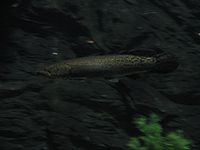Bowfin (Amia calva)
From The Aquarium Wiki
(Redirected from Cottonfish)
Bowfin
Amia calva
568 Litres (150 US G.)
100-110 cm (39.4-43.3")
Freshwater
6.6 - 7.2
22.2-23.9°C (72 -75 °F)
8-12 °d
1:1 M:F
10-12 years
Family
Amiidae
Contents
Additional names
- Bowfin, Mudfish, Cottonfish, Cypress Trout, Freshwater Dogfish, Grindle, Marshfish, Scaled Ling, Speckled Cat, Western Mudfish
Additional scientific names
- Amia canina, Amia cinerea, Amia lentiginosa, Amia lintiginosa, Amia marmorata, Amia occidentalis, Amia ocellicauda, Amia ocellicaudata, Amia ornata, Amia piquotii, Amia reticulata, Amia subcaerulea, Amia subcoerulea, Amia thompsoni, Amia viridis
Origin[edit]
- North America: St. Lawrence River, Lake Champlain drainage of Quebec and Vermont west across southern Ontario to the Mississippi drainage in Minnesota.
Sexing[edit]
- Once sexual maturity is reached, males will retain the "eye spot" near the base of the caudal fin. Females will lose this. Males will often have green-coloured ventral fins.
Tank compatibility[edit]
- Bowfin may take food from any area of their space. They have a relatively small mouth with a primitive design, but this mouth is extremely powerful and contains sharp, conical teeth. Be wary of keeping small fishes together with the Bowfin as it can be a voracious predator.
Diet[edit]
- When available, Bowfin will almost always show preference to small crustaceans such as shrimp and crayfish. They may also eat frogs and other fishes. Young individuals will readily take insects as well.
Feeding regime[edit]
- Feed once or twice a day depending on selected diet.
Environment specifics[edit]
- Bowfin can grow to be quite large, so a large tank is needed. While a well-oxygenated tank is a fine thing to have, it is not required for the Bowfin. Bowfin are non-obligate air-breathers and can choose to either diffuse dissolved oxygen into their blood via their gills or they can diffuse atmospheric oxygen into their blood via a highly vascularised air-bladder. The latter is accomplished by taking "breaths" at the water surface.
Behaviour[edit]
- Bowfin are quiet fish to keep - except at feeding time. They will actively seek out their food using sight as much as a well-developed sense of chemoreception, or "smell." Their pre-maxilla is included in their gape (as a salmon's) and Bowfin need to grab their food. Sharp, conical teeth hold the food in place while a single, gular plate is used to crush it. They will seek food in any area of their tank.
- Bowfin receive their name from a long dorsal fin that they use to make slow backward and forward movements by undulating it up and down their back as a "bow."
Identification[edit]
- Bowfin can be identified by a long, single dorsal fin atop a cylindrical body with an asymmetrical caudal fin. The pelvic girdle is posteriorly placed. Two stubby tubercles sit at the end of a short snout. All individuals are brown in colour; juveniles, however, will often have strong reticulations throughout the body and have a caudal eye spot.
Pictures[edit]
External links[edit]
- Fishbase (Mirrors:
 )
)


